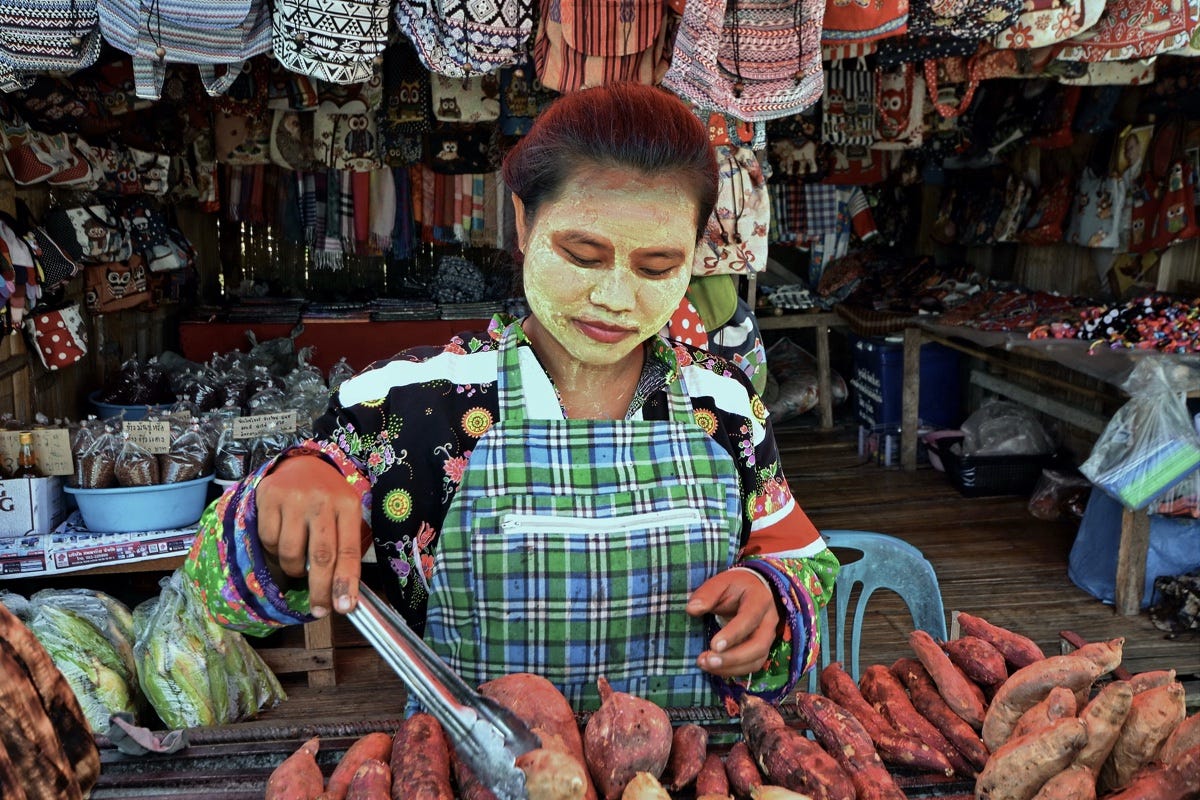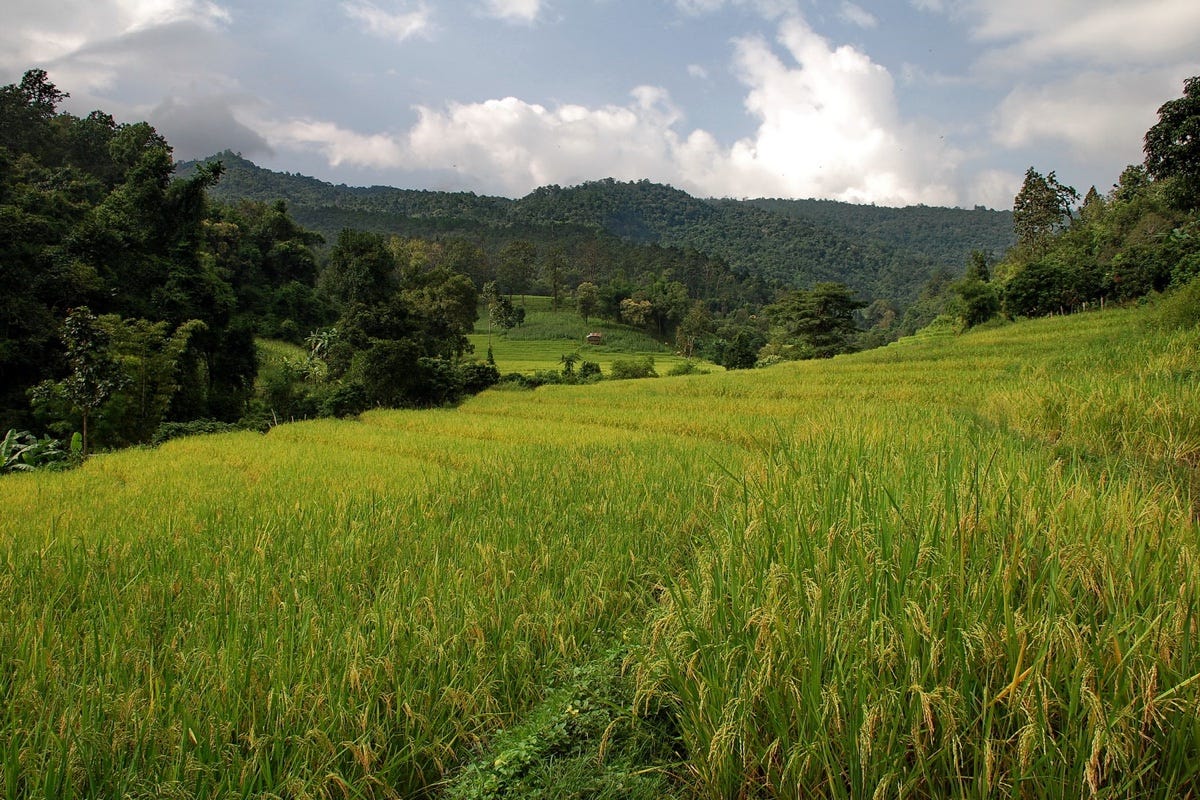Hello to all the new subscribers off the back of yesterday’s post on Covid and Southeast Asia! A quick explainer on Couchfish, this is primarily a travel newsletter—it isn’t always about Covid! The paid version (from US$7 per month), comes out Monday, Wednesday and Thursday and traces a fantasy itinerary through Southeast Asia—you can see the itinerary so far here. The free posts, like this one, come out twice a week, Tuesdays and Fridays and cover a wide gamut of topics. I’ve marked all of these posts on a map here. Some are like the Covid post, others like this one—on a cool trip in northern Thailand.
Enjoy!
The north of Thailand has plenty to offer on the touring front, be it by scooter, car, or even bus. Often the first trip people try, and with good reason, is the Mae Hong Son Loop. Starting and ending in the northern centre of Chiang Mai, you can cover it in as little as two days, or as long as two months. Here’s how you do it.
Blood pressure dropping. A bucolic scene on the Ping River. Photo: Mark Ord.
For decades Chiang Mai has been the epicentre of northern Thailand’s tourism scene. Travellers came first for cooler weather, trekking, and as a base to explore. Today there’s temples, food, nightlife, and oodles of affordable (and not so) lodgings. Despite all these other offerings, the original reasons for visiting persist.
The Mae Hong Son Loop encompasses some of Chiang Mai province along with Mae Hong Son. Much of the latter sidles against Burma and offers both scenery and a cultural mix. Most often done by scooter, the roads are also fine for car, while if you prefer to do it by bus, you can.
Doi Luang beckons. Photo: Mark Ord.
From Chiang Mai you head out north through Mae Rim on Route 107. Eventually you’ll reach a left to Route 1095, but I say start with a detour—continue north. Follow Route 107 for about 30 km north to Chiang Dao and have your first night there.
While Chiang Dao town has little to recommend it, to the west, near the same–named cave, sit a cluster of good spots to stay. You can with ease drop a few nights here. Explore the cave, sample the food, or even do an overnight camping trek to the summit of Doi Luang. More intrepid travellers should consider a trip north to Arunothai. You can get there by songtheaw, but if you have your own transport, explore some of the back roads. Once you’re ready to move on, backtrack to Route 1095 and head west.
The P in Pai stands for pretty. Photo: Mark Ord.
Route 1095 leads up through the mountains to Pai. One of the the north’s most popular backpacker spots, this isn’t everyone’s cup of tea, but it is undeniably pretty. Popular as much for trekking and rafting as for sitting around losing time, do make the effort to explore a bit. Depending on your schedule, allow anything from two nights to two months.
Moving on from Pai, next stop is Pangmapha—better known to travellers as Soppong. Some describe it as Pai–lite, but it is far smaller—a blink and you’ll miss it style spot. Best known for Tham Lod, an enormous bat–filled cave you can raft through, this is another spot to lose time. In business since 1984 (though temporarily closed due to Covid), Cave Lodge is the place to stay. Set down a trail off the main road, if you thought Pai was messing with your itinerary, Cave Lodge is even worse!
Wilderness near Soppong. Photo: Mark Ord.
Once you manage to peel yourself away from the nightly fireside chats at Cave Lodge, press on west. If you have the time, Mae Lana, off a northwards spur, is worth a night—both for its sleepy village vibe and forest walks. If not, press on to Mae Hong Son.
The provincial capital, misty Mae Hong Son dropped a little off the traveller radar in the late 90s. Why? As Laos grew in popularity, foreign travellers started running out of time and would turn back at Pai. The scene today is more focused on the domestic trade, which means, among other things, the food got better! There is an influence, both on the cuisine and the temples, from Burma’s Shan State, making for an interesting spot.
Grazing for yams in Mae Hong Son. Photo: Mark Ord.
As with Pai, there are plenty of day trips you can do from here, to the north and south, and also out to the Burmese frontier. If you have time for just one, consider a day–long trip to what was once a KMT hangout, Ban Rak Thai. While you can reach there by songtheaw, having your own wheels pays dividends when it comes to the views
While the road south from Mae Hong Son isn’t as mountainous as earlier legs, it is nevertheless pretty. Weaving though vast stretches of forest, if you have the time, break the trip for an overnight stop at Khun Yuam. This is a great base for a trip to Mae Surin Waterfall—with an 80 metre drop, the tallest in Thailand. Also not far from town lies the slopes of Doi Mae U-Kho—which is famous for sunflower fields.
Mae Surin Waterfall. Tumbling into a hole in the Earth. Photo: Mark Ord.
South again brings you to the small junction town of Mae Sariang. If you’d like to see Burma, you can travel west to Mae Sam Laep and wave to it over the pumping muddy waters of the Salween. Mae Sariang is also a coin toss spot—continue south, eventually to Umphang, or lake a left and begin to close in the loop. Today we’re taking a left.
Route 108 coasts inland, leaving Burma and the teak forests behind. You can pass through Ob Luang National Park, or turn north on Route 1088 towards Mae Chaem, then 1192 to Doi Inthanon. As you’ve already seen the tallest waterfall, why not swing by Thailand’s highest peak?
Scenery on the way to Doi Inthanon. Photo: Mark Ord.
From Doi Inthanon, you can veer north via Mae Wang, or south via Chom Thong and then ease yourself back into the southern reaches of Chiang Mai.
Have fun!
Nuts and bolts
All the major legs are straightforward to do with minibus or songtheaw services. From Mae Sariang onwards, if you want to go via Mae Chaem and Doi Inthanon, it will take a bit of time, but direct to Chiang Mai is easy. For detailed transport information please see the related destination write–ups on Travelfish.
Most opt to do this by scooter. Always, always, always wear a helmet. Read your travel insurance carefully. If you’re unlicensed it is unlikely you will have any insurance cover in the event of an accident. The trip is also easily done by car and Chiang Mai has around 82 bazillion scooter and car rental outlets.
Couchfish is 100 percent independent and reader–supported. If you’d like to show your support, become a paying subscriber today for just US$7 per month, or simply share this story with a friend. Thank you!

















